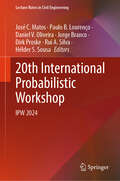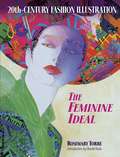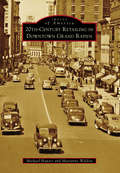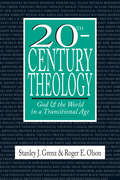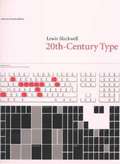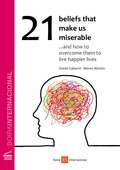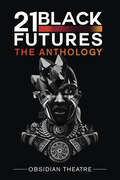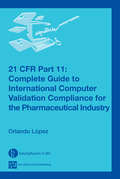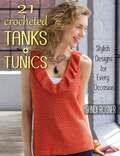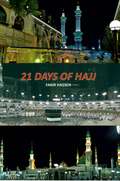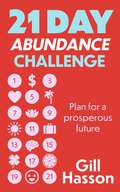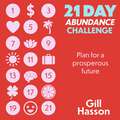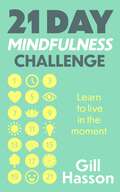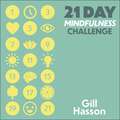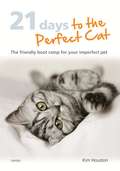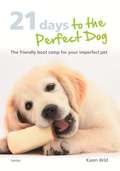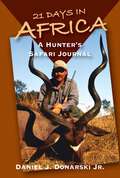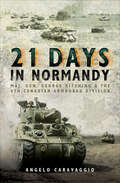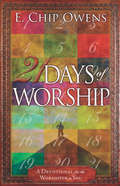- Table View
- List View
20th International Probabilistic Workshop: IPW 2024 (Lecture Notes in Civil Engineering #494)
by Dirk Proske Paulo B. Lourenço Jorge Branco José C. Matos Daniel V. Oliveira Rui A. Silva Hélder S. SousaThis volume presents the proceedings of the 20th International Probabilistic Workshop (IPW), which was held in Guimarães, Portugal on May 8-10, 2024. Probabilistic methods are currently of crucial importance for research and developments in the field of engineering, which face challenges presented by new materials and technologies and rapidly changing societal needs and values. Contemporary needs related to, for example, performance-based design, service-life design, life-cycle analysis, product optimization, assessment of existing structures and structural robustness give rise to new developments as well as accurate and practically applicable probabilistic and statistical engineering methods to support these developments. These proceedings are a valuable resource for anyone interested in contemporary developments in the field of probabilistic engineering applications.
20th-Century Fashion Illustration: The Feminine Ideal
by Rosemary Torre Harold KodaA captivating retrospective of 20th-century styles, this original survey explores the social context of fashion with informative text and over 70 striking images. Profiles include the newly emancipated woman of the 20s, WWII-era glamour girls, flower children of the 60s, the 80s cult of fitness and perfection, and the dawn of the 21st-century obsession with celebrity styles.
20th-Century Retailing in Downtown Grand Rapids (Images of America)
by Marianne Weldon Michael HauserFor decades, downtown Grand Rapids enjoyed a long run in the limelight as the epicenter of shopping in western Michigan. The vibrant Monroe Avenue corridor included three homegrown department stores, several chain department stores, five-and-dime stores, and scores of clothing and specialty retailers. It weathered mother nature, wars, the Great Depression, the advent of neighborhood shopping centers, and civil disturbances--but the one change it could not overcome was the regional shopping mall.
20th-Century Theology: God the World in a Transitional Age
by Stanley J. Grenz Roger E. OlsonRecipient of a Christianity Today 1993 Critics' Choice Award Now in paperback! Stanley Grenz and Roger Olson offer in this text a sympathetic introduction to twentieth-century theology and a critical survey of its significant thinkers and movements. Of particular interest is their attempt to show how twentieth-century theology has moved back and forth between two basic concepts: God's immanence and God's transcendence. Their survey profiles such towering figures in contemporary theology as Karl Barth, Rudolf Bultmann, Dietrich Bonhoeffer, Reinhold Niebuhr, Paul Tillich, Jurgen Moltmann and Wolfhart Pannenberg. It critiques significant movements like neo-orthodoxy, process theology, liberation theology and theology of hope. And it assesses recent developments in feminist theology, black theology, new Catholic theology, narrative theology and evangelical theology. An indispensable handbook for anybody interested in today's theological landscape.
20th-Century Type (New & Revised Edition)
by Lewis BlackwellThis book surveys the significant issues that have shaped the history and evolution of typography and graphic design, showing how current typographic trends are part of a continuously changing movement that can be plotted through the decades from the 1900s to the 1990s.
21 Army Group: Normandy To The Baltic [Illustrated Edition] (Memoirs Of Field Marshal Montgomery #1)
by Field Marshal Viscount Bernard Law Montgomery of Alamein KG GCB DSO PC[Illustrated with 46 highly detailed maps of the actions]Field Marshal Montgomery commanded the Eighth Army from 13th August 1942 until the 31st December 1943, and the 21st Army Group from 1st January 1944 until the German surrender on the 5th May, 1945. Whilst in command of the British Army of the Rhine, in occupation of Germany, shortly after the end of the Second World War Montgomery set out to record the exploits and victories of the troops under his command.Both this volume and its companion volume, El Alamein to the River Sangro, are superb examples of military history as presented by one of the greatest generals to command victorious armies in the field. The texts are taken from his personal war diaries and are distinguished by his incisive style. The whole strategy and course of these two campaigns are presented to the reader with great clarity and accuracy.In Normandy to the Baltic the Field Marshal unfolds that greater task -- the planning and implementation of the greatest invasion the world has ever known -- Operation Overlord. He describes the whole plan behind. D Day and the Battle of Normandy. He continues with the battle for Caen and the capture of Cherbourg, the closing of the Falaise Pocket and the crossing of the Seine--through into the Low Countries and the Battle of Arnhem and the famous Battle of the Ardennes. He concludes with the battle of the Rhineland, the crossing of the Rhine and the rush across northern Germany to the final surrender. The whole pattern of the complex allied effort -- British, Canadian and American -- is described with extraordinary detail and each episode is analysed in retrospect.
21 Beliefs That Make Us Miserable ...and how to overcome them to live happier lives
by Daniel Gabarró Nieves MachínMany social beliefs cause us to suffer because they’re false. That’s why we need wisdom to help us leave them behind in order to live happier lives. You’ll find this information here. This book has been written in a direct and clear way which gets right to the point. It has so much useful information explained in a clear way that you’ll want to read it again and again, and, with each additional reading, you’ll deepen your understanding. It will soon be the book on your bedside table. You don’t have to believe anything, just verify the information it contains and you’ll see how your life becomes filled with peace and harmony. Furthermore, the book also includes practical exercises to integrate its contents into daily life. We’re not looking to fill your mind with theory, but rather to transform your life in a real and practical way. We hope this book represents a turning point in your life.
21 Black Futures: The Anthology
by Obsidian TheatreWhat is the future of Blackness? Obsidian Theatre presents twenty-one versions of it.In 2021, Obsidian Theatre engaged twenty-one writers to create twenty-one new stories about imagined Black futures. Twenty-one to celebrate Obsidian’s twenty-first anniversary in 2021. Each playwright was tasked with scripting a ten-minute monodrama in response to the question “What is the future of Blackness?” To counter the intense early-pandemic isolation and the trauma of witnessing heightened violence toward Black bodies, Obsidian’s goal was to give as many opportunities to as many diverse Black artists as possible and to bring new voices together from both theatre and film. It was a grand experiment to create a rich tapestry of possibilities and to uplift Black artists in the process.A radical offering in unprecedented times, newly appointed Obsidian artistic director Mumbi Tindyebwa Otu’s curatorial aim was joyful, aspirational, and empowering: come together in this moment and create something communal, unapologetically Black, and with the Black gaze at its centre—art as the architecture for creating those futures. Includes plays by Amanda Parris, Cheryl Foggo, Shauntay Grant, Donna-Michelle St. Bernard, Lawrence Hill, Djanet Sears, and many others.
21 CFR Part 11: Complete Guide to International Computer Validation Compliance for the Pharmaceutical Industry
by Orlando LópezCovering regulatory requirements stipulated by the FDA, this book delineates the organization, planning, verification, and documentation activities and procedural controls required for compliance with worldwide computer systems validation regulations. The author introduces supporting technologies such as encryption and digital signatures and places
21 Crocheted Tanks + Tunics: Stylish Designs for Every Occasion
by Sandi RosnerCrochet yourself cool with fashionable sleeveless tops that will fit your style! Crocheted fashion isn't just for cold weather with the 21 refreshing designs in this book, perfect on their own or as layers.
21 DAYS OF HAJJ
by Fakir HassenFakir Hassen’s passion for reflecting the activities and achievements of the South African Indian community and relations between India and South Africa through his keyboard and lenses has been documented in 12 books already. This 12th volume, once again in his preferred style of non-academic writing, is a special one, as Hassen embarks on a personal Religious journey that he shares in a largely non-spiritual way with readers. In the process, he provides an insight into what goes on behind the scenes during the annual Hajj pilgrimage, probably the largest religious gathering in the world as millions of pilgrims converge on holy sites in Saudi Arabia on a single day. As usual, Hassen also provides some basic information on Relations between South Africa and the country he writes about, in this case Saudi Arabia, in a very readable way that should prove to be an easy and interesting read for both Muslims and those of other faiths as well for many, this book could be a first-time look into the pilgrimage that every Muslim tries to undertake at least once in a lifetime
21 Day Abundance Challenge: Plan for a prosperous future
by Gill Hasson21 Day Abundance Challenge combines the empowering concepts of abundance and the law of attraction with a clear, three week programme of reflective exercises and practical approaches.With this book you'll learn how to stop being living with less. You'll learn how a better understanding of yourself and what you wish for, an open mind and positive thinking will bring abundance to your life.Each and every day you will discover:- How abundance is a state of mind that you can tune in to and benefit from- The unlimited abundance available to you right now- A world of options and opportunities that are waiting for you - How to move towards a life of effortless, continued prosperity- Why three weeks is enough to change your attitude and begin creating an abundant life
21 Day Abundance Challenge: Plan for a prosperous future
by Gill Hasson21 Day Abundance Challenge combines the empowering concepts of abundance and the law of attraction with a clear, three week programme of reflective exercises and practical approaches.With this book you'll learn how to stop being living with less. You'll learn how a better understanding of yourself and what you wish for, an open mind and positive thinking will bring abundance to your life.Each and every day you will discover:- How abundance is a state of mind that you can tune in to and benefit from- The unlimited abundance available to you right now- A world of options and opportunities that are waiting for you - How to move towards a life of effortless, continued prosperity- Why three weeks is enough to change your attitude and begin creating an abundant life
21 Day Abundance Challenge: Plan for a prosperous future
by Gill Hasson21 Days is all you need to start attracting abundance and planning for a prosperous future.21 Day Abundance Challenge combines the empowering concepts of abundance and the law of attraction with with a clear, three week programme of reflective exercises, meditations and facts.With this deeply practical audiobook, you'll learn how to stop being satisfied with less, focus on what really matterd to you, and learn how to use positive thinking, mental alertness and good energy to attract abundance to your life.Every day you'll learn (at least!) three new approaches, and will discover:- How abundance is a state of mind that you can tune in to.- How improving your self-esteem will help you attract happiness and success.- How to move towards a life of effortless prosperity.- Why three weeks is enough to change your attitude and begin creating an abundant life.(P) 2023 Hodder & Stoughton Limited
21 Day Mindfulness Challenge: Learn to live in the moment
by Gill Hasson21 Day Mindfulness Challenge combines the empowering, mind altering approach of mindful thinking with a clear, three week programme of meditations, reflective exercises and practical approaches.With this book, you will discover how mindfulness can become a permanent, positive habit.Day by day you'll learn :- How to ground yourself, gain perspective and remain calm- How to access and benefit from mindful acceptance and a beginners mind- How to use mindfulness as a starting point for how you approach everyday challenges- Why three weeks is enough to kick start a more positive empowering attitude and approach to yourself, your life and other people
21 Day Mindfulness Challenge: Learn to live in the moment
by Gill Hasson21 Day Mindfulness Challenge combines the empowering, mind altering approach of mindful thinking with a clear, three week programme of meditations, reflective exercises and practical approaches.With this book, you will discover how mindfulness can become a permanent, positive habit.Day by day you'll learn :- How to ground yourself, gain perspective and remain calm- How to access and benefit from mindful acceptance and a beginners mind- How to use mindfulness as a starting point for how you approach everyday challenges- Why three weeks is enough to kick start a more positive empowering attitude and approach to yourself, your life and other people
21 Day Mindfulness Challenge: Learn to live in the moment
by Gill Hasson21 Day Mindfulness Challenge combines the empowering, brain-altering approach of mindful thinking with a clear, three week programme of reflective exercises, meditations and facts. With this deeply practical audiobook, mindfulness will become a locked in habit.Every day you'll learn (at least!) three new approaches, and will discover:- How to calm down, gain perspective and regroup- How to vary the intensity or focus of mindful exercises for any situation- How to use mindfulness as a starting point for how you approach everyday challenges- Why three weeks is enough to pierce the bubble of stress you're used to carrying around with you.(P) 2022 Hodder & Stoughton Limited
21 Days To A Happier Family
by Justin CoulsonEveryone wants their family to be happy, but so much gets in the way - work stress, commitments and our children's challenging behaviour are some of the usual suspects. Less obvious obstacles are our own habits and expectations, a reactive parenting style, and even a lack of clarity about what makes a family truly happy. As a result, families often seem fragmented, stressed and out of control. <p><p> Kidspot parenting expert Justin Coulson knows how to make families happier. In this book, he combines cutting-edge insights from positive psychology with classic psychological research to help parents identify and develop habits that will strengthen their family. In his trademark warm and empathic style Justin covers topics like finding the most effective parenting style for your child, getting relationships right and how that leads to effective discipline, using mindfulness in parenting, being emotionally available to your children - and so much more.
21 Days To The Perfect Cat
by Kim HoustonSimple, structured and effective, this 21-day course will prevent problem behaviour and, over subsequent days, encourage positive interaction, so that your cat continues to behave well. Exercises are given for each day in the training plan, with reinforcement of the previous day's learning scheduled in, as well as time for relaxation and play with your cat. The first section helps you to assess your key concerns so that you can tailor the programme to fit your needs, while a 'quick fix' section after the main training plan providing you with 50 speedy solutions to common problems, such as damaging furniture or unsociable behaviour towards strangers. Easy to fit in around your life, with this book you are just 21 training days away from the perfect cat.
21 Days To The Perfect Cat: The friendly boot camp for your imperfect pet
by Kim HoustonSimple, structured and effective, this 21-day course will prevent problem behaviour and, over subsequent days, encourage positive interaction, so that your cat continues to behave well. Exercises are given for each day in the training plan, with reinforcement of the previous day's learning scheduled in, as well as time for relaxation and play with your cat.The first section helps you to assess your key concerns so that you can tailor the programme to fit your needs, while a 'quick fix' section after the main training plan providing you with 50 speedy solutions to common problems, such as damaging furniture or unsociable behaviour towards strangers.Easy to fit in around your life, with this book you are just 21 training days away from the perfect cat.
21 Days To The Perfect Dog: The friendly boot camp for your imperfect pet
by Karen WildSimple, structured and effective, this 21-day course will prevent problem behaviour and, over subsequent days, encourage positive interaction, so that your dog continues to behave well. Exercises are given for each day in the training plan, with reinforcement of the previous day's learning scheduled in, as well as time for relaxation and play with your dog. The first section helps you to assess your key concerns so that you can tailor the programme to fit your needs, while a 'quick fix' section after the main training plan providing you with 50 speedy solutions to common problems, such as damaging furniture or unsociable behaviour towards strangers. Easy to fit in around your life, with this book you are just 21 training days away from the perfect dog.
21 Days To The Perfect Dog: The friendly boot camp for your imperfect pet
by Karen WildSimple, structured and effective, this 21-day course will prevent problem behaviour and, over subsequent days, encourage positive interaction, so that your dog continues to behave well. Exercises are given for each day in the training plan, with reinforcement of the previous day's learning scheduled in, as well as time for relaxation and play with your dog.The first section helps you to assess your key concerns so that you can tailor the programme to fit your needs, while a 'quick fix' section after the main training plan providing you with 50 speedy solutions to common problems, such as damaging furniture or unsociable behaviour towards strangers.Easy to fit in around your life, with this book you are just 21 training days away from the perfect dog.
21 Days in Africa
by Daniel J. Donarski Jr.A real-life adventure story of hunting wild game in Africa. Suggestions for planning your own African safari, with tips on rifle selection, travel insurance, preparations.
21 Days in Normandy: Maj. Gen. George Kitching & the 4th Canadian Armoured Division
by Angelo Caravaggio&“Right[s] some of the injustices done to the Canadians&” on their maligned actions during the Invasion of Normandy. &“An absorbing account&” (Firetrench). The Canadian Fourth Armoured Division crossed the Channel in July 1944 to support the invading forces and assist in the Allied attempts to break out of the Normandy beachhead. They were heavily engaged in Operation Totalize and Operation Tractable but have been criticized for their failure to close the &‘Falaise gap&’ and complete the entrapment of withdrawing German forces. Their commander, Major General George Kitching, was relieved of his command after just twenty-one days in action. Angelo Caravaggio reexamines the division&’s performance and particularly that of its leadership. Using new information, he establishes that, despite entering battle for the first time during one of the most challenging phases of Allied operations in August 1944, the 4th Armoured Division, under Kitching&’s leadership, proved resilient and adaptive in overcoming the volatile and unpredictable nature of warfare in Normandy. The combat operations of August 1944 transformed the division into a battle-hardened combat formation that would later distinguish itself through its ability to generate a sustained drive across France out of the chaos and destruction of the Normandy battles. &“The author uses new information to demonstrate the unit did show flexibility and adapted to the battlefield quickly, despite being thrown into battle during one of the Normandy Campaign&’s critical phases. His arguments are detailed and based upon in-depth research, and the book has many detailed maps to help the reader follow the action.&” —Warfare History Network
21 Days of Worship: A Devotional for the Worshiper in You
by E. Chip Owens"I will bless the Lord at all times; his praise shall continually be in my mouth. My soul makes its boast in the Lord; let the humble hear and be glad" (Ps. 34:1–2).Author and pastor E. Chip Owens presents these twenty-one daily devotions to nurture the worshiper in you. Each passage will encourage you to adopt a lifestyle of worship as you learn valuable lessons such as how to bring pure worship before God, and why the Bible says God inhabits the praises of His people.When you create an atmosphere of worship, you invite God&’s presence into your life. The heavenly insight of 21 Days of Worship will inspire you to keep your focus on the Father and meditate on Scripture daily. Be prepared to receive your breakthrough and live on a new level in Christ!
